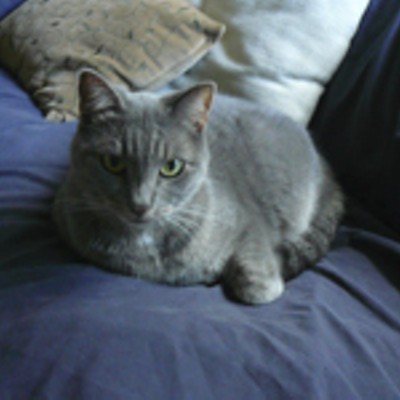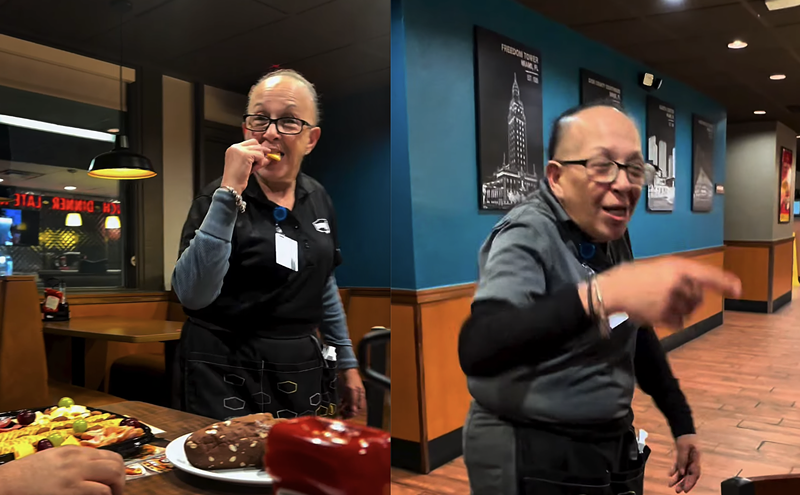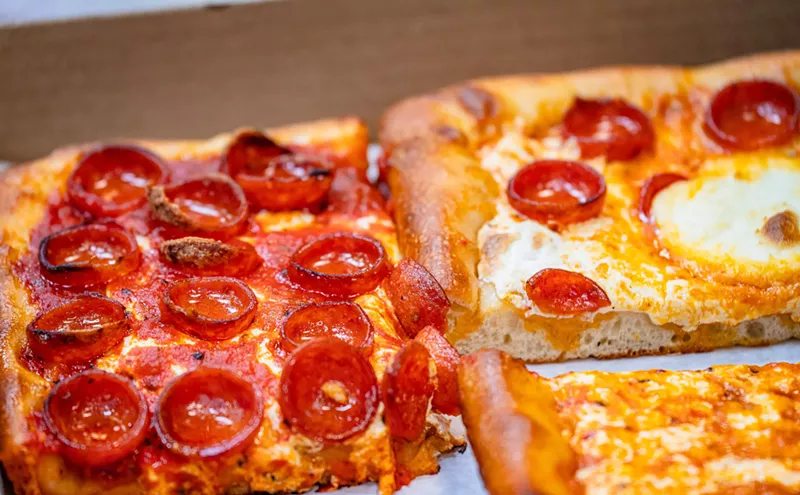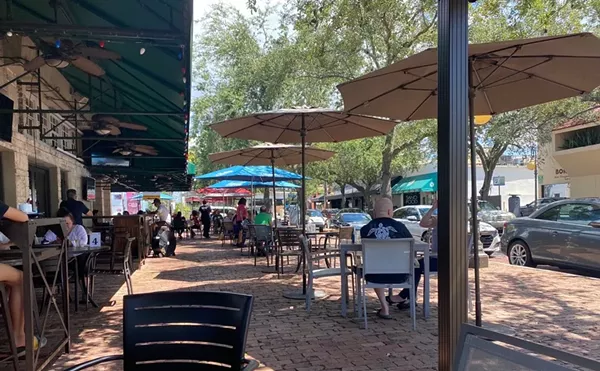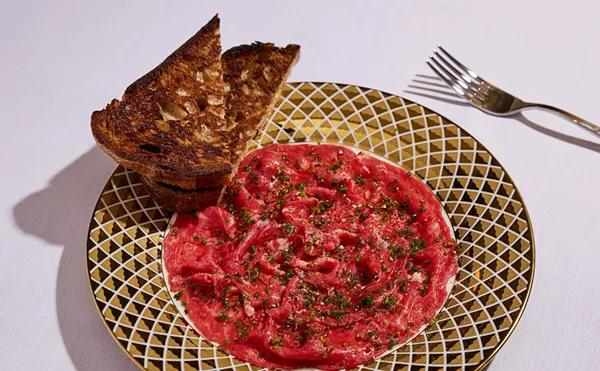In doing research for this weeks' New Times review of Naoe, I emailed chef/owner Kevin Cory to ask the meaning of the kanji characters that are part of the restaurant logo. His answer was fascinating, but way too long to put in a review. This mini-memoir delves into Cory's family history in Japan, the evolution of his restaurant Naoe, and how the two relate to each other and to the kanji characters. So sit back, pour yourself some chilled sake, and enjoy a good read.
"NAOE is my Japanese family name. In order to truly provide the exact meaning of my characters' art and logo, I must explain a little about my family's roots, my family relations, my inspiration and motivations. Because every day I look at it, I am humbled, and driven to someday prove myself worthy:
My family is from Oono, Kanazawa. Kanazawa is a verrry culturally rich area of Japan. Oono is a tiny dot along the Sea of Japan & Kanazawa's port/inlet. (There is an Ono/Oono city in another area of Japan. My Oono is the one most people never heard of.) Oono is an historical semi-hidden dot shoyu town. Kanazawa has about 500,000 people. But Oono is only about the size of Eastern Shores in North Miami Beach.
My family's history and location make sense for the kanji's skeleton, explained in the files (one in photo above, one after the jump). In Japan's countryside, you'll find many families have lived in the same tiny neighborhood for hundreds of years, doing a specialty trade thats dependent upon their geography and local culture. But the exact meaning for my characters' art goes a bit deeper into my life...
When I was 7 years old, my Mom took me to Japan for a few months. I
fondly remember my Uncle Choyu would always take me for walks and my
Aunts Etsuko & Koko would cook for us with Etsuko's daughter Chieko
stopping by (she is married to revered artist Katsura Funakoshi). In
1999, before I went to Toyama to work with my Chef Uncle, Yasushi, we
all reunited -- along with Yasushi's wife, Kiyoshi. Kiyoshi is so
incredibly nice and her Japanese breakfasts were superb! My Aunt Koko
lived in Kamakura. She took us to Tsurugaoka Hachimangu (the symbolic
shrine of Japan's old capital city, Kamakura) where she showed me our
relative's "omiki" (sake offering to the Gods). That was when I first
learned of my family's sake brewery. Unfortunately, a few years later,
both of my oldest surviving aunts, Koko & Etsuko, passed away.
In 2005, I tried to obtain a location to open a restaurant. I
originally liked the idea to use my "Japanese family name" for a "small
Japanese restaurant". But ever since I was old enough to answer the
phone, whenever someone called for my Mom, people would always
mispronounce her name with absolutely no confidence. So I dismissed
the idea.
I searched for an easy to pronounce name/word foreigners could
recognize as being Japanese, even though it may not be as appealing to
Japanese. Restaurants are very risky and this is America, not Japan.
I came up with "Kitano". It is elegant, easy to pronounce, and there
was an ukiyoe artist named Kitano from where my Mom's from too;
provides a story to link my heritage as Japanese. But I found "Kitano"
was trademarked by the Kitano Hotel in NYC. I asked if they'd mind.
They said, OK (for just a tiny restaurant far far away). But when I
asked for their signature, they changed their mind.
The next name for my restaurant was "Kamakura", although perhaps again
generic to Japanese people [like being in Japan and seeing a restaurant
named Aventura or Grammercy(they have)], its strong sounding, easy to
pronounce, foreigners can recognize it as Japanese and it provides a
story for my Japanese heritage.
About March/April 2006, I was about to sign a lease for "Kamakura" in
Jade Brickell Bay. But then my mom had a stroke. So I stopped the
deal to help my mom. At that time, I coincidently saw a sake catalog
with my relative's sake brewery. Being fortunate to have time with my
Mom, I asked her about the sake brewery, but she didnt have
information; she is the youngest of 11 siblings, and shortly after WWII
her Father, Naoe Genhichiro, passed away. The economy was awful and the
siblings had to scatter....She then said, her Father had a shoyu
brewery. I was surprised after 10 years of making sushi why she never
told me. She said, "I told you. But you never listen to me." LOL
A couple of months after my mom's fortunately strong recovery, I went
to Kanazawa to find my roots and to meet my shoyu and sake relatives. I
was extremely excited. I assumed that they were just one of a thousand
breweries. I didnt care. All I wanted to do was say hello. Little did I
know...
Of course I researched the top dining experiences of Kanazawa and spent
hours discussing the area with concierges. While there, I entered a
local sake shop at Kanazawa's main marketplace, Omicho. One of my
relative's sakes was displayed for 26,000 Yen. I spoke a little broken
Japanese with the shop owner, never mentioning any relations. She
poured me a couple glasses of other local sakes to taste. She asked
how I liked them and either she got the impression I had an
appreciation for good sake or was incredibly kind, because she reached
into the refrigerator and pulled out that expensive bottle of my
relative's sake and poured me a glass...I tasted it...I did backflips!!
It was the softest, smoothest and nicest aroma sake I ever had. I felt
like I tasted sake for the very first time!
I went to a few of the top ryoteis & ryokans in Kanazawa. Knowing
of Kanazawa's rich culinary culture, I definitely wanted to experience
"Kaga Ryori" [Cuisine of Kaga --the area's old name]. When they asked
if I would like beer or sake, I always chose sake and asked them to
choose the one that matched best. The first two places I went matched
Kaga Ryori with my relative's sake -- and for the sashimi course, they
used my relative's shoyu!! Each time, I about had a heart attack! And
the shoyu was so soft and smooth, you could drink it.
Before I left to Kanazawa, I found a ryokan website, Asadaya, with an
elegant country style since 1867. For an aspiring high-end natural
Japanese chef, the cuisine's picture shown then was like a dream. I
definitely planned to visit. My Uncle, Yasushi took a 7-hour train ride
to meet me in Kanazawa to take me to the shoyu brewery the next day. I
didnt want him to just eat and sleep. He was 71 then and still looked
very strong. So after a quick dinner, I asked him if he'd like to take
a walk.
He hadn't been to Kanazawa city in 40 years. He looked lost.
(actually, coming back to the hotel by Kanazawa Castle we did get lost
in the rain). But during our walk, he suddenly stopped in his
tracks...he stared at a townhouse shop, then shook his hand pointing at
it and said, "This is the first place I worked as a Chef when I was 19
years old." I was like, nooooo waayyyyy! What were the chances?! I
looked at the sign, but I couldn't read it.. Then he said, "Asadaya".
The day after we went to the shoyu brewery, I went to an incredible
vegetarian restaurant for monks (shojin ryori) that I had been dying
to experience. After our meal, while waiting for my fiance to return,
the owner's wife chatted with me. It turned out she is a business
partner with my shoyu family owner's wife for something else. My
Kanazawa family is in a small circle of Kanazawa's historical high-end
culture. There were other HUGE coincidences I had in Kanazawa too --
but these are probably enough.
At the end of my trip of destiny, after reuniting with my Japanese
family, meeting new family, and witnessing the role my Kanazawa
relatives have in such a rich culture, there was absolutely no way I
could use a generic name for my resturant. Since I've already proven
myself with my own set of high standards as a Sushi Chef in Miami, then
the opportunity for a new brand name is only deserving for my Japanese
family's name. "NAOE" resurfaced way at the top of my list again.
I returned to Miami and tried to figure out how to overcome NAOE's
pronunciation problem and create a logo. I printed out a draft business
card and went with a friend to eat at a sushi bar and show him. The
sushi chef was Peruvian. He also saw the card from afar and perfectly
said, "NA-O-Eh". I suddenly realized that Japanese and Spanish are
phonetically similar, and Miami is so Latin. That was it. NAOE was
confirmed.
I spent months artistically analyzing and redrawing my Japanese family
name's kanji many many many times, even with help from a champion
calligrapher who redrew it 40 times. Even though she drew very
elegantly, I was never satisfied with the expression to capture my
situation. I could simply draw it with a thick brush and it would
still be nice and unique to myself from the uniqueness of one's own
hand writing. But I wanted more symbolism within to capture &
inspire my mission.
I looked back again at the calligraphy inside my relative's shoyu
brewery over a door that says "shoyu brewery" with a small "NAOE" name
below, written in the old style direction of right-to-left. After
months of intensely studying the characters for NAOE, when I relooked
at those characters, I finally realized something very special within
that adds onto their basic skeleton's meaning:
In the "E" character, look at the "3 dots on the left (water)";
It looks like a person holding something, perhaps a bottle. The three dots are the head, body, and hand.
Still in the "E" character, look at the "sideways H (carpenter's square/huge inlet/arm of the sea)";
It looks like two sides of a counter. The craftsman/shop owner standing
behind his (Carpenter's square) counter with the other side open and
awaiting.
For the "NAO" character;
It looks like a Kitamae ship which used to travel around Japan, bringing konbu from Hokkaido, shoyu from Kanazawa, etc.
This artistic intent finally became apparent or at least its partly how
I see it. Then almost 200 years after the shoyu brewery started in
1825, a descendent was born and raised all the way in Miami, and
modestly speaking, becomes the city's premier Japanese Chef for the
characters to represent the same:
In the "E" character, look at the 3 dots on the left.
It looks like me (an itamaesan) in uniform, holding my knife.
Still in the "E" character, look at the "sideways H".
My cutting board is on the left.
My hinoki counter is on the right. [Btw, the Historical Nakamura
Brewery is made of hinoki (and so is inside Kanazawa Castle). See it
on my website]
For the "NAO" character.
It symbolizes a Haulover fishing boat I've been known to pull live fish
from, as well as for my slogan, "Its Not Fresh... its Alive."
Its one of the main reasons why I don't open until after 7pm, because the boats return so late.
Showing the old way of writing (right to left), instead of vertical or
left-to-right also seems important to me. I feel it shows respect to
history, as well as introducing my family's history for the kanji
itself. Combined with the English characters going left-to-right for
NAOE below shows how the old & new flows nicely together which also
inspires me to "learn from the old and create the new" (a strong
Japanese belief).
The rest of the logo:
The straight fonts without serifs for NAOE are elegant, classic, and undistracting from the subtle brush strokes above.
The red rectangle box around NAOE symbolizes:
*the simple clean parallel lines within my restaurant's space,
*my hinoki countertop,
*matches the colors of Japan (Red, Black & White),
*symbolizes heat (a restaurant),
*provides symmetry
*and the empty space all around and in the overall background crucially balances everything together.
In essence, I've become determined that far far away in Miami, I will
quietly prove myself with the hopes that someday my Japanese family can
be proud -- yet I'll feel it is never possible and undeserving, which
will drive me to keep building. That's the feeling I wanted for myself
when I look at my logo; reflect on my life, become humbled by history,
feel inspired for something unachievable, as well as provide a deep and
clean aesthetic for a first time viewer."


